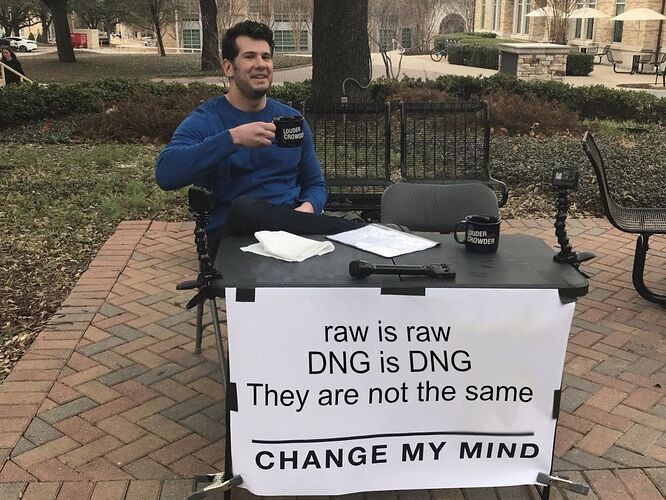Due another thread going off topic:
Ah, finally someone with common sense made a threat I can link to people who think DNG = RAW by default. Hehehe. Kudos.
Reminds of a retoucher friend who was ask to deliver DNG’s even if he worked in Photoshop on them as composites with heavy retouching involved. He could not explain to them its a container like MP4 or mkv (Matroska) so he just saved it as DNG and they though they were getting the raw files. True story. Some people just refuse to understand it.
Even ChatGPT (GabAI) knows what it is.
DNG, or DNG Format, is a digital negative specification developed by Adobe Systems. It is a universal file format designed to store raw image data from digital cameras, as well as other metadata related to the image. The format is intended to provide a single, standardized format that can be used by photographers, imaging software, and other applications.
Some key features of DNG include:
Compression: DNG uses lossless compression to reduce file size without compromising image quality.
Metadata: DNG supports a wide range of metadata, including camera settings, lens information, and editing history.
Standardization: DNG is an open format, and Adobe encourages other companies to adopt it as a standard for raw image data.
Flexibility: DNG can be used with a variety of file types, including TIFF, JPEG, and PNG.
Archival: DNG is designed to be a long-term archival format, with the ability to preserve image data and metadata for future use.
Overall, DNG aims to provide a universal format for storing, sharing, and archiving digital images, while also preserving the original raw data and metadata. This can help photographers maintain the highest possible image quality and ensure that their images can be edited and processed in a wide range of applications.
I think they never claimed to be a respiratory of DNG’s created by other software, but rather a RAW processing applications than can export in Linear DNG for further processing in other RAW apps, like Lightroom, Capture One etc. Basically the main reason behind use of DNG and in particular Linear DNG by the DXO is to provide service of their RAW developing technology to those who do not want to leave the Lightroom for example, but want the benefit of said DXO technology.
Of course DXO was always built and promoted as RAW developing software, not an universal image editor, like Photoshop or Affinity Photo. Once you remove RAW format from the equasion, even if you have DNG container, you lose the ability to perform same level of image editing, because the data is missing. DXO does however offer support for its own linear DNGs. Personally I would prefer for DXO to stay specialized and best in class in what they specialize in, than to become Jack of All Trades, master of none, bloated mess. Its a relatively small company, and I think that is where proper innovation still happens. And besides its a healthy contra balance to giants like Adobe.
Thank you! Finally, someone who gets it. Want to know more?
Love it!!!
Mark
